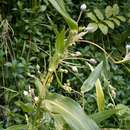en
names in breadcrumbs


Coix /ˈkoʊɪks/ is a genus of Asian and Australian plants in the grass family.[3][4]
The best-known species is Coix lacryma-jobi, widely called Job's tears. Its variety Coix lacryma-jobi var. ma-yuen is cultivated in many warm regions as a source of food, medicine, and ornamentation.[5][6]
The generic name is from Ancient Greek κόϊξ (koix), which originally referred to the doum palm (Hyphaene thebaica); the fruits of the doum palm resemble the diaspores of Coix.[7]
[2] see Chionachne Polytoca Tripsacum
This genus was formerly placed in the Maydeae, now known to be polyphyletic.[Sch 1]
Members of this genus produce their own variety of α-zein prolamins. These prolamins have undergone unusually rapid evolutionary divergence from closely related grasses, by way of copy-number changes.[Sch 2]
Coix /ˈkoʊɪks/ is a genus of Asian and Australian plants in the grass family.
The best-known species is Coix lacryma-jobi, widely called Job's tears. Its variety Coix lacryma-jobi var. ma-yuen is cultivated in many warm regions as a source of food, medicine, and ornamentation.
The generic name is from Ancient Greek κόϊξ (koix), which originally referred to the doum palm (Hyphaene thebaica); the fruits of the doum palm resemble the diaspores of Coix.